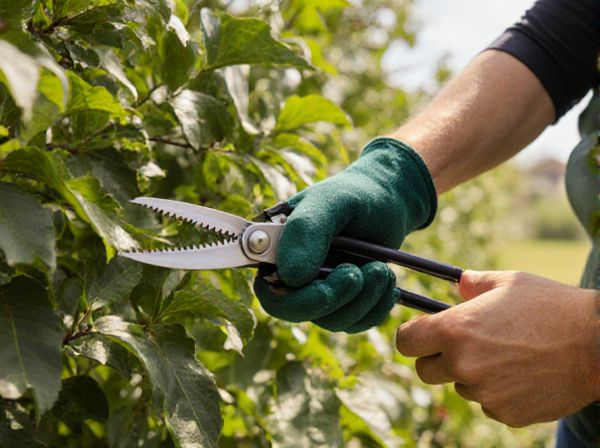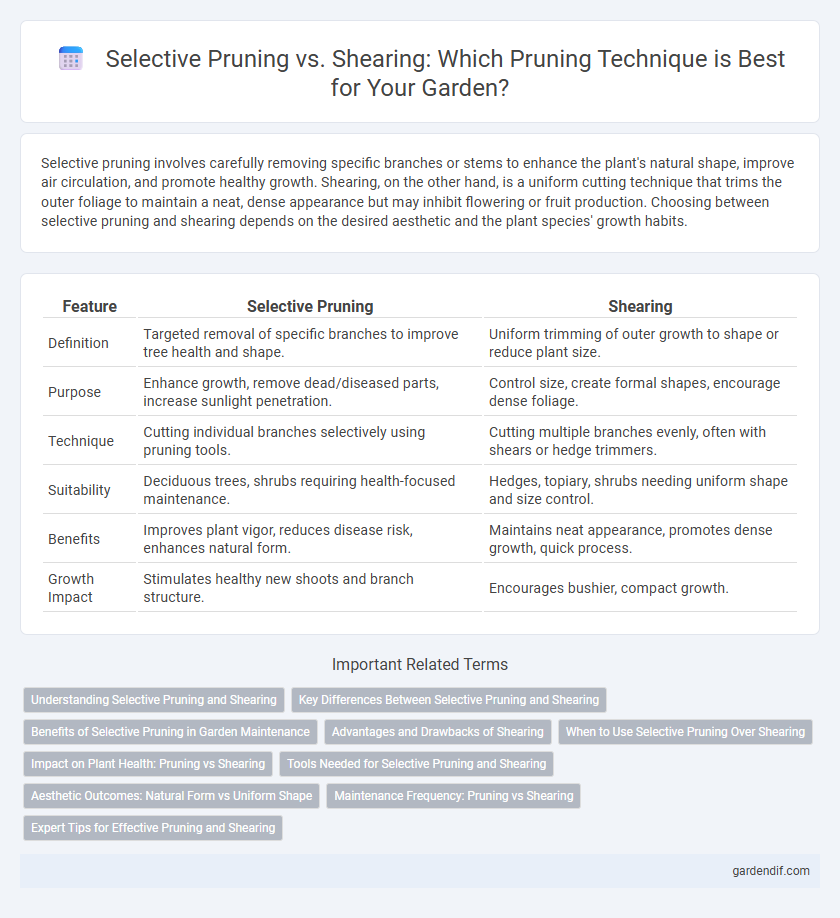
Selective Pruning vs Shearing Illustration
Selective pruning involves carefully removing specific branches or stems to enhance the plant's natural shape, improve air circulation, and promote healthy growth. Shearing, on the other hand, is a uniform cutting technique that trims the outer foliage to maintain a neat, dense appearance but may inhibit flowering or fruit production. Choosing between selective pruning and shearing depends on the desired aesthetic and the plant species' growth habits.
Table of Comparison
| Feature | Selective Pruning | Shearing |
|---|---|---|
| Definition | Targeted removal of specific branches to improve tree health and shape. | Uniform trimming of outer growth to shape or reduce plant size. |
| Purpose | Enhance growth, remove dead/diseased parts, increase sunlight penetration. | Control size, create formal shapes, encourage dense foliage. |
| Technique | Cutting individual branches selectively using pruning tools. | Cutting multiple branches evenly, often with shears or hedge trimmers. |
| Suitability | Deciduous trees, shrubs requiring health-focused maintenance. | Hedges, topiary, shrubs needing uniform shape and size control. |
| Benefits | Improves plant vigor, reduces disease risk, enhances natural form. | Maintains neat appearance, promotes dense growth, quick process. |
| Growth Impact | Stimulates healthy new shoots and branch structure. | Encourages bushier, compact growth. |
Understanding Selective Pruning and Shearing
Selective pruning targets specific branches or shoots to improve plant health, structure, and fruit production by removing only the most problematic parts, such as dead or diseased wood. Shearing, in contrast, involves trimming the outer growth uniformly to maintain shape and size, often used for hedges and topiary. Understanding these techniques allows gardeners to choose between promoting natural growth patterns with selective pruning or achieving immediate visual uniformity through shearing.
Key Differences Between Selective Pruning and Shearing
Selective pruning involves the precise removal of specific branches or stems to improve plant structure, health, and fruit production, targeting only unwanted growth. Shearing, by contrast, consists of uniformly trimming the outer edges of shrubs or hedges to maintain a desired shape, often resulting in dense but less natural growth. The key differences lie in selective pruning's focus on internal canopy management versus shearing's emphasis on external shaping.
Benefits of Selective Pruning in Garden Maintenance
Selective pruning promotes healthier plant growth by carefully removing specific branches to improve air circulation and sunlight penetration, reducing disease risk. This technique enhances the natural shape and structure of plants, preserving their aesthetic appeal while boosting overall vigor. Targeted cuts also conserve energy within the plant, supporting more robust flowering and fruit production compared to the more drastic tissue removal in shearing.
Advantages and Drawbacks of Shearing
Shearing provides a uniform appearance and is ideal for quickly shaping hedges or shrubs, making it a popular choice for formal gardens and landscape designs. However, this method can lead to dense outer growth that shades inner branches, potentially causing poor air circulation and increasing susceptibility to diseases. Unlike selective pruning, shearing does not allow for targeted removal of dead or weak branches, which may impact the overall health and vitality of the plant.
When to Use Selective Pruning Over Shearing
Selective pruning is ideal when maintaining tree health and structure by removing specific branches without altering the overall shape, especially during the growing season. Shearing is better suited for shaping hedges and shrubs quickly but can stress plants and reduce airflow if overused. Use selective pruning over shearing when promoting better light penetration, air circulation, and targeted removal of diseased or damaged limbs.
Impact on Plant Health: Pruning vs Shearing
Selective pruning removes specific branches to enhance airflow, light penetration, and overall plant structure, promoting better growth and reducing disease risk. Shearing cuts back entire outer layers uniformly, which can lead to dense growth that limits air circulation and creates stress points, potentially increasing susceptibility to pests and diseases. Pruning fosters long-term plant health by encouraging natural form and vigor, while shearing prioritizes aesthetics but may compromise plant resilience.
Tools Needed for Selective Pruning and Shearing
Selective pruning requires precision tools like bypass pruners, loppers, and hand saws to make clean cuts on individual branches or stems, ensuring healthy plant growth and minimizing damage. Shearing typically involves hedge shears or electric trimmers designed to cut multiple stems simultaneously, shaping shrubs into uniform forms. Proper tool selection impacts plant health, influencing wound healing and overall aesthetic outcome.
Aesthetic Outcomes: Natural Form vs Uniform Shape
Selective pruning enhances aesthetic outcomes by preserving the natural form and encouraging organic growth patterns, resulting in a more visually appealing and ecologically balanced landscape. Shearing produces a uniform shape by trimming foliage evenly, which creates a formal, manicured look but can sacrifice the plant's natural contours and health. Prioritizing selective pruning supports diverse textures and natural beauty, while shearing emphasizes symmetry and precise geometric shapes.
Maintenance Frequency: Pruning vs Shearing
Selective pruning requires less frequent maintenance compared to shearing because it targets specific branches to promote healthy growth and structure. Shearing typically mandates more regular trimming to maintain uniform shape and density, often monthly or bi-monthly during the growing season. This difference in maintenance frequency impacts labor costs and plant health, with pruning supporting long-term plant vitality and shearing favoring aesthetic uniformity.
Expert Tips for Effective Pruning and Shearing
Selective pruning targets specific branches to improve tree health and structure, while shearing involves trimming entire sections to maintain shape, often used for hedges. Experts recommend using sharp, clean tools to prevent disease and making precise cuts at branch collars for selective pruning to promote better healing. For shearing, consistent trimming intervals help maintain dense growth and desired form without stressing the plant.
Selective Pruning vs Shearing Infographic

 gardendif.com
gardendif.com